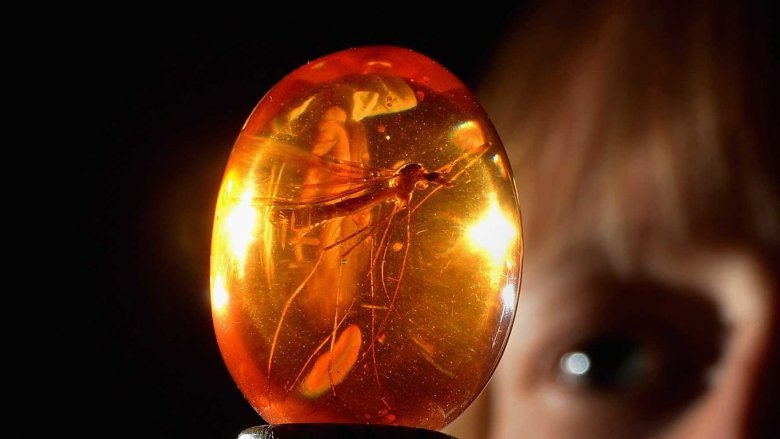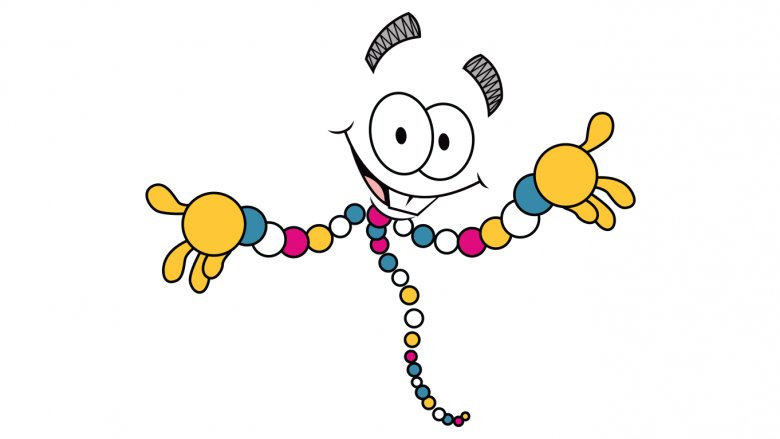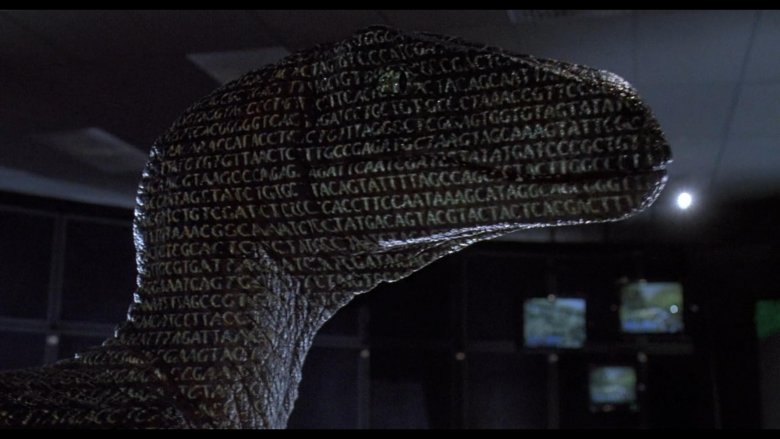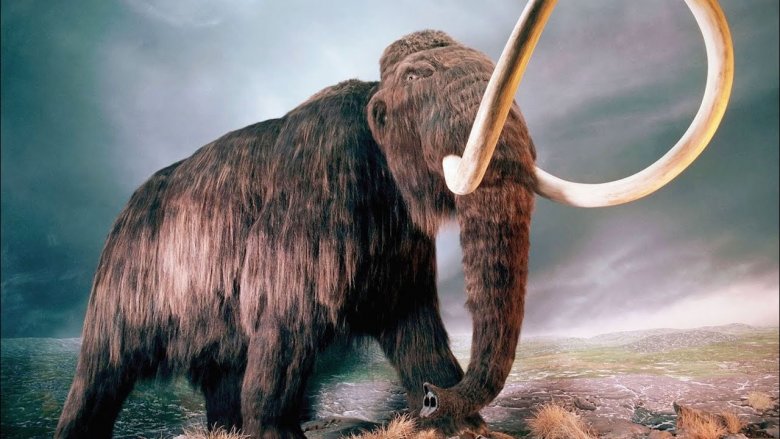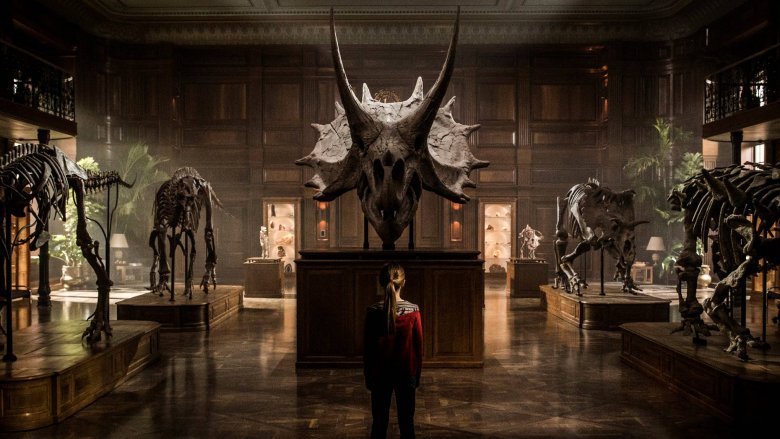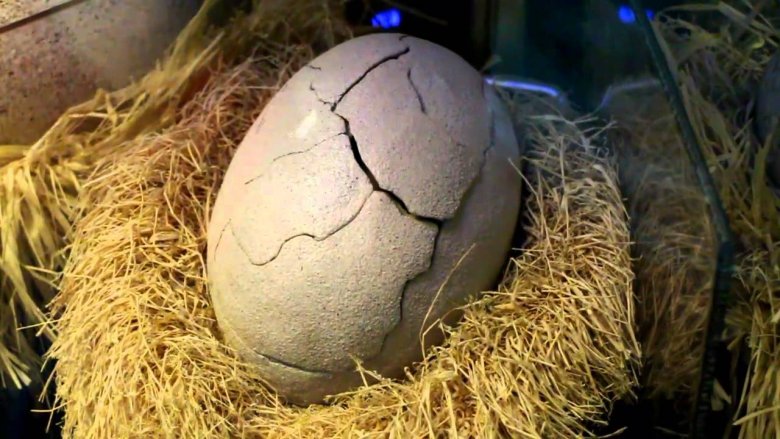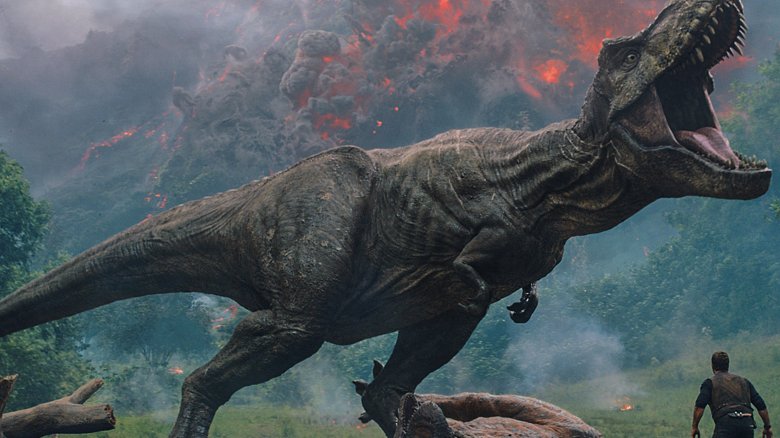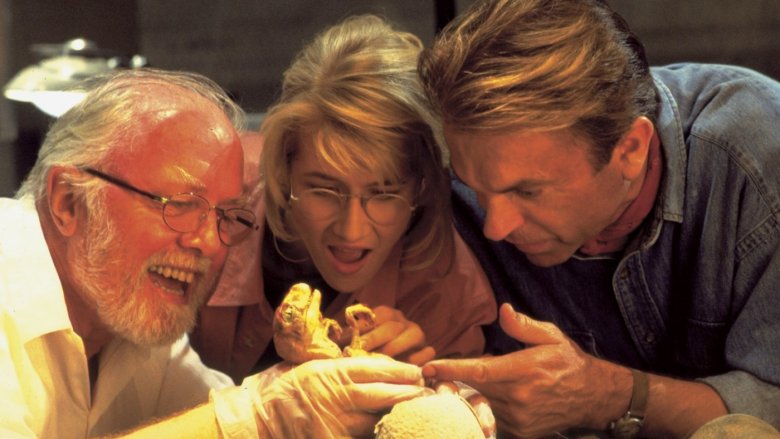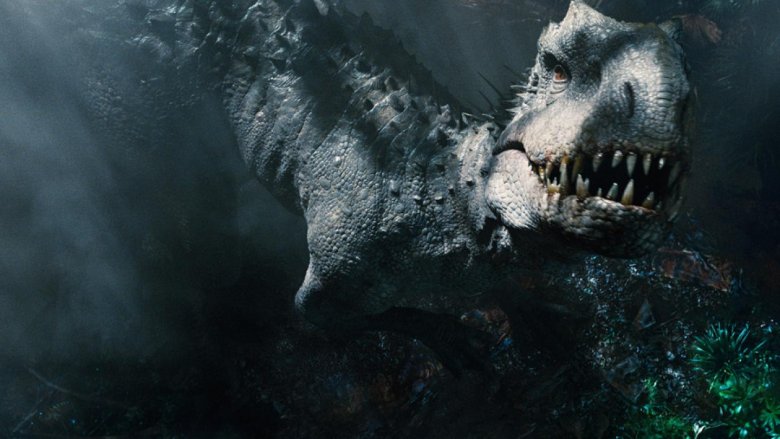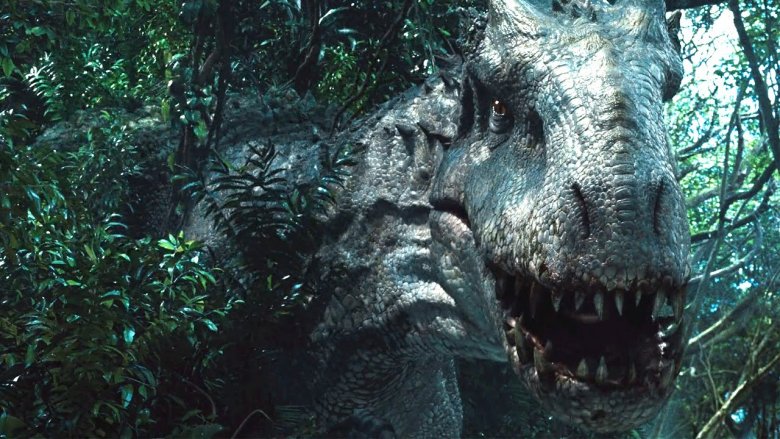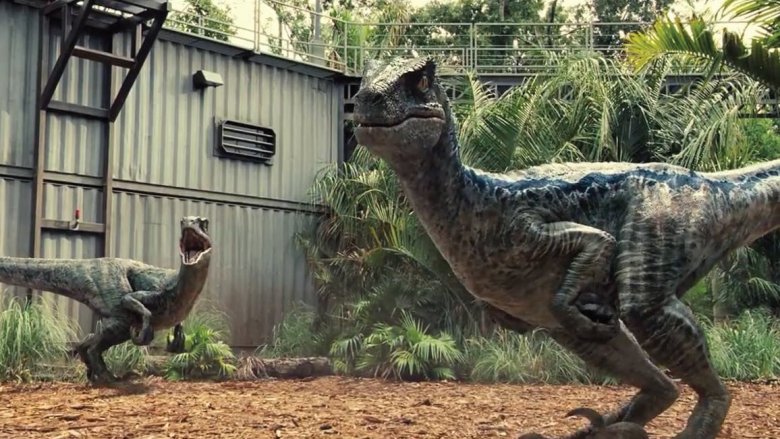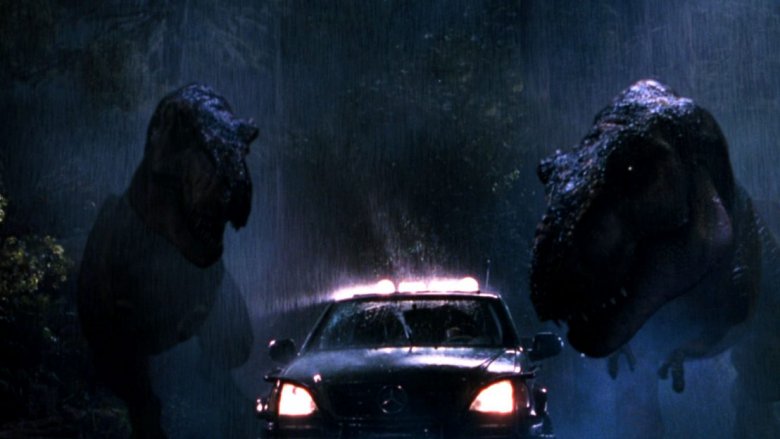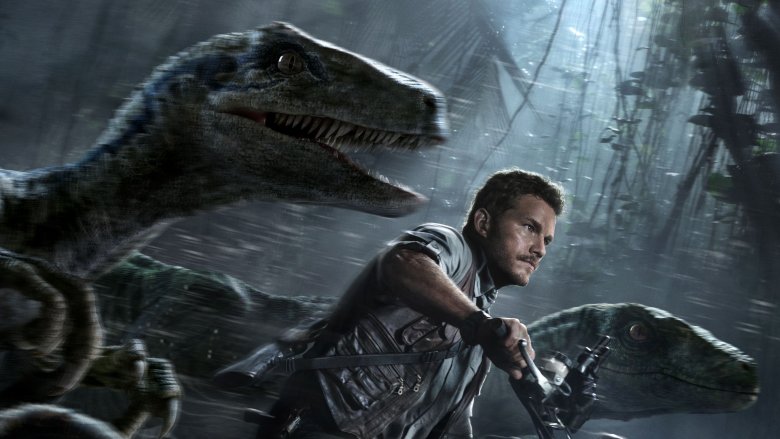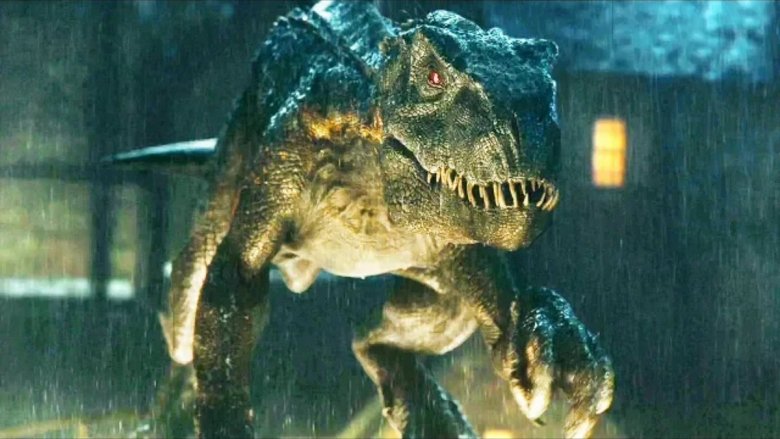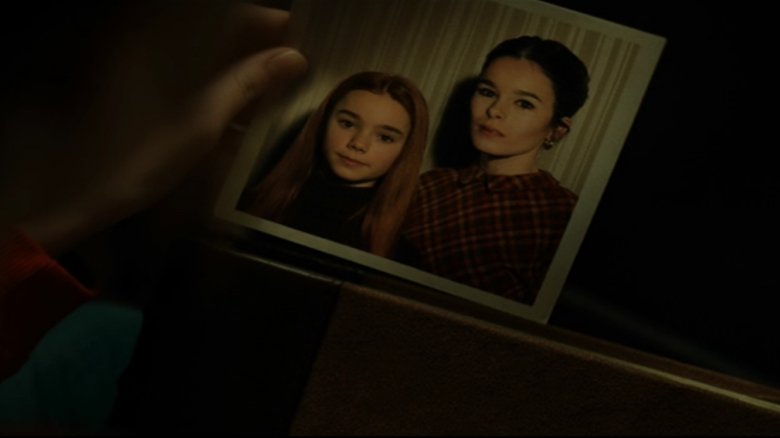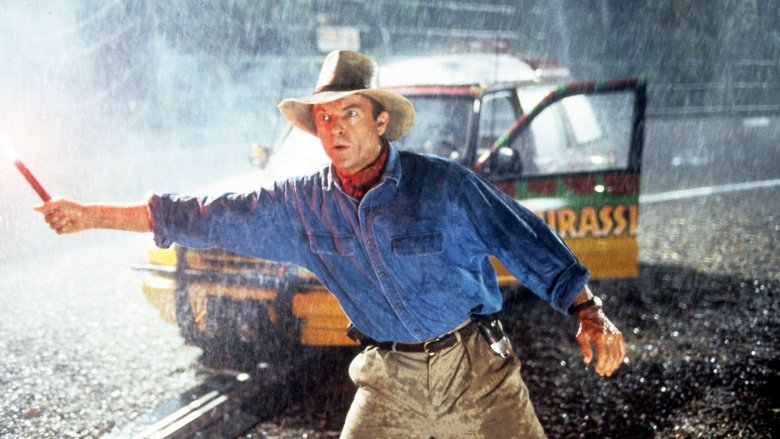The Science Behind Jurassic Park Explained
Jurassic Park had cutting edge visual effects, the acting talents of Jeff Goldblum, the magic touch of Steven Spielberg, and a memorable soundtrack composed by none other than John Williams. Despite the film's success and continuing legacy, there's a fatal flaw behind the Jurassic Park franchise: the science.
There are threads of truth in novelist Micheal Crichton's well-researched pseudoscience, but as a whole the movies have taken some serious liberties with the laws of nature. Tyrannosaurus rex likely had excellent vision, raptors weren't nearly so big and scaly, and most of the dinosaurs in the park are actually from the Cretaceous period, just to name a few fallacies. This isn't to say that all of the science in the films is fake: most of the near-magical scientific achievements chronicled in the movies are based on really real facts and discoveries by really real paleontologists and geneticists. We don't blame the production for ignoring the research papers and making everything bigger, badder, and more cinematic, but we are going to break down where Jurassic Park went wrong when it comes to the science.
Jurassic Park was built on dino DNA
Jurassic Park doesn't really create dinosaurs so much as clone them. We're given the rundown as to how exactly this miracle of science came to be through a whimsical, animated feature in the first film. Mr. DNA himself explains that blood contains DNA, and in order to make dinosaurs, John Hammond's expert squad of scientists had to find dinosaur blood. Fossilized mosquitoes in amber served as the source behind the park's collection of dino DNA.
Once the blood was collected from the mosquitoes, the DNA was sequenced — which is a monumental task. Geneticists sequenced the whole of the dinosaur's genome and patched in missing parts with DNA from frogs. With the complete code for a dinosaur/frog hybrid, Jurassic Park was then able to implant the chromosomes into an egg. Tada! You now have the makings of a baby dinosaur.
Disregarding the mind-boggling amount of time it takes to sequence a genome, it seems like a fairly simple process, right? Deceptively simple, author Micheal Crichton has left some canyon-sized gaps in his otherwise very scientific explanation as to how John Hammond resurrected the long-dead dinosaurs.
Reassembling the DNA: genetic engineering
Micheal Crichton is famous for his fictional explorations of the furthest reaches of science; from resurrecting dinosaurs to artificial intelligence to time travel, his novels take a very serious, stringently researched approach to science fiction. Crichton leaves little up to interpretation and explains in excruciating detail the insides and outs of how the science in his books should — theoretically — work. And all this theory is based on real, peer-reviewed, scientific research.
When Crichton was writing Jurassic Park, he firmly believed that genetic experimentation and manipulation was the technology of the future. Although not nearly as present in the films, the books show how various corporations are willing to do whatever it takes to make the next leap in genetic engineering, ethics be damned. This is a theme continued in other novelssuch as Next, which questions whether or not a living person's cells can be licensed and then owned by a corporation. Crichton had his finger on the pulse of the latest in genetic engineering, and in some ways he was ahead of his time.
De-extinction
What the well paid, highly qualified folks at Jurassic Park are doing is de-extinction: taking an extinct organism and cloning it, giving it life in the here and now. New gene-editing capabilities previously only seen in fictional films like Jurassic Park are now available to genetic researchers, allowing them to explore the real possibilities of de-extinction. No, that doesn't mean we'll see a T. rex anytime soon.
But we might see something that looks incredibly close to a real, live wooly mammoth. A Harvard team has been working on splicing mammoth genes into the DNA of an Asian elephant. The goal is to produce a hybrid "mammophant," but there is no saying how long that process might take — or if it ever gets approved due to the ethical dilemma around resurrecting a long-dead species. The closest science has come to a real Jurassic Park scenario is the Lazarus Project, which successfully cloned embryos of the extinct gastric-brooding frog in 2013. Those embryos died after just a few days, but it's considered an astounding success that they ever lived at all.
Bad news for Jurassic Park: DNA decays
The whole concept of reviving dinosaurs in Jurassic Park relies on the idea that the fictional scientists can easily extract DNA from mosquitoes fossilized in amber. This idea is unlikely at best, impossible at worst. The books mention that John Hammond has amber mines at his disposal, but even then, how many bugs laden with dino DNA are those miners likely to find? Not enough to supply a whole amusement park with a previously extinct menagerie.
Even if Hammond stumbled upon the motherlode of frozen mosquitoes, the DNA within them is not actually frozen in time. DNA, like all other organic material, decays. The reason why Harvard researchers think it's more likely that they could clone a mammoth is because their samples are only around 4,000 years old, rather than 66 million. The Jurassic Park method of extracting genetic material is unlikely to supply geneticists which much, if any, viable DNA to work with; the dinosaurs would be more frog than terrible lizard in the end. We're not going to lie: we'd still buy a season pass even if that were the case. Frogs are cool.
Where do Jurassic Park's eggs come from?
Jurassic Park figured out how to create dinosaur chromosomes. But that's only half the battle. In 2013, scientists were able to get together the complete genome of an extinct frog, but that particular pollywog isn't hopping around today. This is because even with all the genetic information, the chromosomes have to be implanted into an embryo. Project Lazarus' embryos died after a few days, never producing a viable fetus.
So how did Jurassic Park do it? This is one of those details that Crichton was hoping we wouldn't look too closely at. Once you have the chromosomes, you need eggs. The books claim that parent company InGen has the tech to create artificial eggs with artificial yolks into which the dinosaur nucleus is injected. Okay, maybe this is another moment where Crichton is ahead of his time. The films, however, are way off base: they claim that they use unfertilized ostrich or emu eggs. Science shakes its knowledgeable head at that. A much closer relative would be required, despite the fact that emus are just as scary as any Velociraptor.
These dinosaurs aren't even from the Jurassic period
Jurassic Park made hard-to-pronounce, scientific names household words: Velociraptor, Gallimimus, Pterodactyl, and the titular term Jurassic. There is an interesting exclusion, however, of the word "Cretaceous." The truth of the matter is that some of the most famous names in dinosaur-dom actually come from the Creataceous period rather than the Jurassic period, which are separated by tens of millions of years.
The Tyrannosaurus rex, Triceratops, and Velociraptor are all firm residents of the Cretaceous Period, rather than the Jurassic. Denizens of the Jurassic with famous bone structures were the Stegosaurus, Pterodactyl, and the T. Rex-esque Allosaurus. The Cretaceous was the final era of terrible lizards before the meteor turned their meat into ash. So why is the park known as Jurassic Park? Maybe Crichton just thought it sounded better than Cretaceous Park, and easier to spell for that matter. The revamped Jurassic World features the Cretaceous Cruise, where vacationers can kayak among the lazy-eyed Stegosaurus.
Lady dinosaurs producing young all by themselves? It's happening now
While the films give a basic explanation as to why the park's all-female animals were suddenly able to reproduce, the books go into deep detail (not like that, you pervert) as to how a bunch of lady lizards were able to start producing young without the help of a male. This is yet another moment where Crichton was strangely ahead of his time.
We find out in the books that thanks to the frog DNA spliced into the dinosaur's genes, they were able to change their bodies and become male in order to mate. Reptiles having so-called "virgin births" is not unheard of — and these scaley single ladies don't even have to change their biology. An all-female species of whiptail lizard reproduces asexually. Parthenogenesis, the process of an unfertilized egg reaching maturity and ultimately hatching, has been observed in many reptile species, such as the dinosaur-like komodo dragon, for instance. Raptors repopulating an abandoned theme park? Life, uh, finds a way.
Hybrids are harder to make than you think
Jurassic Park endorses the somewhat dodgy practice of gene splicing. The films make it sound easy to fill in the gaps where the geneticists couldn't complete the DNA sequence. Jurassic Park chose frog DNA to better acclimate the eventual animals to the tropical climate of Isla Nublar.
Frogs are boring. No one really wants to see a giant frog versus a scary, scary dinosaur. Apparently even the likes of the king of dinosaurs, the T. Rex, gets boring, because Jurassic World saw fit to mix it up and make some super-scary hybrids to impress visitors. The Indominus rex was made up of bits of Velociraptor, cuttlefish, pit viper, tree frog, and a host of other dinosaurs. Today, in the real world, it is technically possible to make mutant hybrids — we do it with genetically modified foods. But those anti-freezing and disease-fighting traits borrowed from other organisms aren't observable like big fangs or camouflage capabilities. Adding in the genes capable of expressing those features are one thing; flipping enough genetic switches so that they are expressed is a wholly mysterious, as-yet undiscovered process. We wouldn't know how to make an Indominus rex just yet, thank goodness.
Yes, frogs have superpowers
Why frogs? Frogs make the whole of Jurassic World go 'round, as it turns out. It is their DNA that is chosen to fill in the genetic gaps of the collected dinosaur genomes. Their traits are desirable for acclimating the newly resurrected animals to the tropical island of Isla Nublar, and it's the amphibian ability to change from male to female that led to the doom and destruction of the whole of Jurassic Park.
In Jurassic World, it's again the frog's fault as to why everything got so bloody, so fast. All the park's animals have a little bit of frog in them, but the Indominus rex was a little more amphibian than others. Some tree frogs, namely the red-snouted treefrog, blend into their backgrounds so well that they are invisible in both visible and infra-red light. This cloaking ability is how the Indominus rex, super smart and ultra-sneaky, is able to fool its captors into thinking that it had disappeared from its paddock.
What were raptors really like?
Imagine a raptor. Likely, the image summoned to mind is of the stunning practical effects from the first few Jurassic Park films, wherein the Velociraptors were speedy, man-sized monsters that had thick scales and a pack mentality. This image is completely divorced from the reality of what paleontologists have unearthed about the species.
Crichton may have been confused when writing about Velociraptors. One of Crichton's favorite research books, Predatory Dinosaurs of the World, mislabeled the bigger, badder Deinonychus as a sub-species of Velociraptor. Deinonychus' description better fits the creatures we see on the silver screen, whereas real Velociraptors were small, flighty creatures no taller than around three feet. Recent paleontological finds suggest that they were covered in feathers, their arms like wings. Think big chicken rather than small dragon for an accurate image of Velociraptor.
T. Rex vision based on movement: hoax and a half
Easily one of the most famous fallacies popularized by the Jurassic Park films is the idea that Tyrannosaurus rex's vision is based on movement. That's a comforting idea if you're facing one of the big beasts, but there is little to no scientific evidence to back up this hypothesis. Dr. Allen Grant chooses a, let's say, inopportune time to test this theory when faced with a T. Rex right after the park's power is cut, disregarding the fact that the animal can likely smell him and all his fear.
The books take care to note that this wasn't Dr. Grant's theory, but instead another scientist's. From what we know from real scientists, there is no credence whatsoever to the idea that the T. Rex was anything other than a smart, sharp-eyed hunter. "It's also got a great sense of smell and a great sense of hearing, and all that's really emerged from the CAT scans of its brain, which have all taken place after the year 2000," said palaeontologist Steve Brusatte in an interview with the BBC. Considering the date of this discovery, we can't really blame Crichton, or by extension Spielberg, for exploring this theory.
Who is Jurassic Park's real alpha?
Forget everything you think you know about pack dynamics. Whether it's fluffy wolves or scaley raptors, popular media has been misled about how groups of deadly predators interact and work together. Older research that popularized the idea of an "alpha" of the pack has recently been proven inaccurate.
In this flawed understanding, the alpha takes charge via displays of dominance and force. The strongest rules over the weakest, and if there's a younger, stronger contender, they can usurp the old alpha and take over. This is what happens in Jurassic World when the Indominus rex effectively becomes the alpha of the raptor pack.
However, more recent studies show that familial relationships take precedence over power. The "alpha" is whichever animal is the most like a parent to the rest of the pack. Thus it would make more sense in the films if the raptor pack had stayed loyal to Owen Grady, who had raised them since birth and long established himself as the parent of the group. Since the raptors had imprinted on him, the pack's betrayal of him in favor of the I. Rex doesn't follow current understanding of pack behavior.
Why mothers are important
Since there have been a whole series of films rather than just one, we know that the folks behind Jurassic Park — both well meaning and just plain greedy — don't know when to stop. This is how we end up with the horrifying, murderous "prototype" known as the Indoraptor. The purported "benefit" of this insatiable killing machine is that it can be trained to hunt down specific prey via sound cues. This kind of technique has been used for ages with falcons and dogs.
We use the word "machine" very specifically here. Because unlike a dog or even a hunting bird, the Indoraptor has not been socialized whatsoever. It lacks any bond to a living thing, and all of its relationships to people are negative — it gets tased an awful lot. This is why it was so imperative for Wu's people to get the raptor Blue: they wanted her to act as a mother and for her DNA to be a part of future iterations of the Indoraptor because of her capacity for empathy. She had demonstrated with Owen that she could make an emotional connection with humans, even learn to trust and care about them in her own raptor-y way.
Can people be cloned?
So we know that the theoretical process of de-extinction of dinosaurs is essentially cloning the individual who was bitten by the fateful mosquito that got trapped in amber. Cloning has long been labeled as science fiction, but as it turns out, we do have the technology today to do a fair bit of it. Back in 1996, a sheep dubbed Dolly was born to a surrogate mother that she was entirely unrelated to, the first mammal to be cloned from an adult cell.
Cloning sheep is one thing, but humans? That's impossible, right? Difficult, maybe unethical, but not impossible. In Jurassic World: Fallen Kingdom, we learn that little Maisie Lockwood is actually a clone of her "mother," created with the same technology that resurrected the dinosaurs. The timeline of her mother's death and Maisie's birth don't exactly line up, and this is where those questionable ethics around cloning come in. Cloning is difficult because it's a process of trial and error, and the errors can prove to be fatal. We're talking birth defects and genetic abnormalities, since there is only one parent providing genetic material. This leads to the dark conclusion that it probably took several attempts to clone Lockwood's late daughter in order to create the healthy, fully formed Maisie.
Paleontology was made cool by Jurassic Park
Even with all the scientific errors and misinformation that the books and films spread, we have to give a lot of credit to the Jurassic Park franchise for making science cool. Paleontology and genetic engineering was put on a worldwide platform; the films not only introduced impressionable kids to an interesting career path, but they also opened the door to increased funding of the sciences.
Following the release of the first film, paleontologists and archaeologists enjoyed what has been called the "Jurassic Park phase," wherein enthusiasm for fossils and the pursuit of dino DNA was more ardent than ever. Around this time, great leaps and bounds were made in research into de-extinction, and discoveries that would have usually gone unnoticed by popular press — like the sequencing of an ancient weevil's DNA — became sensational.
However, the film's focus on de-extinction has also been implicated as a distraction; why should we try to revive dead animals when there are living ones in need of protection? Regardless as to whether Jurassic Park's legacy has been a help or a hindrance to the scientific community, its influence is undeniable.
